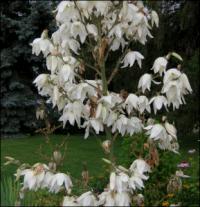Deer Resistant Plants
Showing 169–170 of 170 results
-
Wisteria frutescens syn. Wisteria macrostachya America wisteria Z. 5-8
Lush, dense, drooping, fragrant purplish-blue, pea-like racemes in late summer on new fragrant purplish-blue, pea-like. drooping flower-clusters in early summer on new stems.
Lush, dense, drooping, fragrant purplish-blue, pea-like racemes in late summer on new fragrant purplish-blue, pea-like. drooping flower-clusters in early summer on new stems.
Size: 12-20’ x 4’
Care: sun to part shade in moist, mildly acidic soil For best flowering trim vine to four buds from last year's new growth in late winter or early spring, before this year's growth begins. A legume, so it enriches the soil by adding nitrogen. Seed pods poisonous.
Native: Virginia to FL, west to TX, north to IL
Wildlife Value: Larval host for Marine Blue skipper butterfly. Deer resistantCollected before 1753. Wisteria named “in memory of Caspar Wistar,(1761-1818) M.D. late professor of anatomy in the University of Pennsylvania, and for many years president of the American Philosophical Society: a philanthropist of simple manners, and modest pretensions, but an active promoter of science.” Thomas Nuttall.
-
Yucca filamentosa syn. Yucca americana Adam’s Needle, Silk grass Z 4-10
July – August flowers with translucent white bells, five feet high, out of a clump of spiky evergreen foliage.
OUT OF STOCK
July – August flowers with translucent white bells, five feet high, out of a clump of spiky evergreen foliage.
Size: 30" leaves - 5' flower x 3'
Care: full sun, moist well-drained soil. Drought tolerant
Native: New Jersey to Florida
Wildlife Value: symbiotic relationship with Yucca moth – its only pollinator is the Yucca moth and the Yucca is the only food source for the Yucca moth.
Awards: England's Royal Horticultural Society Award of Garden Merit; Cary Award Distinctive Plants for New England and Elisabeth Carey Miller Botanical Garden Great Plant Pick.IIn 1596 Gerard (1545-1612) named the genus Yucca from the incorrectly identified plant. He named it Iucca. Filimentosa from the Latin “filum” meaning “thread” because of the threads on the leaf margins. Colonists cut the leaves of Y. filamentosa to make thread. Indians used the root as an ingredient in bread, to make suds for cleaning and the leaf fibers to make clothes. For the Cherokee it cured diabetes and skin sores, induced sleep in people and drugged fish for an easier catch. One of earlier No. American plants sent to Europe – grew in Tradescant the Younger’s South Lambeth nursery in 1656. Both Gerard and Parkinson grew Yucca filamentosa in their personal gardens. Jefferson planted this in 1794 and called it “beargrass.” Grown at Elgin Botanic Garden, America’s 1st botanic garden, 1811.


